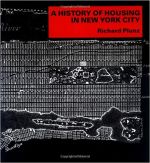A History of Housing in New York City (Revised Edition)

A History of Housing in New York City is a captivating book for architects, urban planners and designers, and historians. It is also of interest for anyone wanting to know how New York’s housing has developed into what it is today. First published in 1983 and now published in this revised edition, it has lost none of its relevance.
From the outset, A History of Housing in New York City transports its readers to New York City in the early 19th century and brings them on a storytelling journey, which reveals how changes in population, technology, building laws and regulations, class differences, and sanitation, among other aspects, have influenced the shape, form and density of New York’s housing. Woven into this story are personal accounts and 339 illustrations (including architectural drawings, spatial plans and photographs), which bring it further to life. The author, Richard Plunz of Columbia University, notes how cities are no longer facing the “scourges of disease and hygiene”, but instead “facing changes in ecology and climate”. In resolving these new global challenges, Plunz believes New York City and other cities are key as the housing question “remains front and center everywhere” (page xliii).
Chapter 1, “Early Precedents”, looks at the government’s initial intervention in New York housing design when the first colonists arrived in 1624. It goes on to discuss the first mandate for professional intervention in housing design in 1809, as well as the introduction of “tenements” following a century of major disease epidemics and fires.
Chapter 2, “Legislating the Tenement”, explains the process of legal intervention in the tenement house problem and the enforcement of building standards in the mid-1800s that led to the Tenement House Act of 1879.
Chapter 3, “Rich and Poor”, notes the technological innovation in form and production of housing in New York that took place in the second half of the 19th century. It considers how this brought with it “the period of greatest inequity between the housing of the rich and the poor New York City has known”, and how squatter settlements not only grew but were aggravated by increased densities (pages 50 and 55).
Chapter 4, “Beyond the Tenement”, discusses the role and influence of architectural experimentation within philanthropic projects, and how this changed housing design from the traditional tenement block.
Chapter 5, “The Garden Apartment”, signifies both a new access to outer borough land brought by New York’s subway development in the early 1900s and a reorganization of capital for the production of middle-income housing (page 130). It also discusses the role of several notable changes in New York’s housing: first, an unprecedented volume of new housing in the 1920s; second, a wave of new-generation architects (no longer largely upper-middle class, but many first- or second-generation immigrants with no formal university training); and third, the US government’s war housing programmes.
Chapter 6, “Aesthetics and Realities”, acknowledges that although it was amongst the most liveable housing in New York (up to today), the Garden Apartment was short-lived (page 164). From here, it describes the stylistic changes in housing that followed and were influenced by both European and American design philosophies, such as those of Lewis Mumford, Le Corbusier and Frank Lloyd Wright, stemming from the political economy of the time.
Moving to the Great Depression of the 1930s, Chapter 7, “Government Intervention”, reveals the federal government’s direct intervention in housing production and their various incentives, including New Deal housing projects.
Chapter 8, “Pathology of Public Housing”, looks at the 1940s and ‘50s as it considers the extraordinary action that World War II forced upon the US government regarding national housing production, and the consolidation of housing agencies into one National Housing Agency (page 247). In this regard, it discusses the economic incentives developed to help urban middle-class housing in New York compete with the suburbs (page 252).
With a lens on the 1960s and ‘70s, Chapter 9, “New Directions”, reflects on “arguably the most innovative period in New York City history” in terms of site planning for non-luxury development (page 280). It looks at the renewed favour for high-rise living or “tower in the park” as the flaws of suburbia and single-family housing became apparent, especially to younger generations.
The last chapter, Chapter 10, “Entropies and Atrophies”, reflects on the decline in new housing production in New York City by the early 1980s (atrophy) as well as political lack of interest (entropy). In response, it highlights a substantial increase in the rehabilitation of buildings and entire neighbourhoods in New York – both for public and private development. To conclude, the epilogue looks at current-day New York City, its shortage in housing, and plans and programmes to build affordable housing, as well as to address current global challenges linked to ecology and climate.
Book note prepared by Hannah Keren Lee
Search the Book notes database
Our Book notes database contains details and summaries of all the publications included in Book notes since 1993 - with details on how to obtain/download.
Use the search form above, or visit the Book notes landing page for more options and latest content.
For a searchable database for papers in Environment and Urbanization, go to http://eau.sagepub.com/

